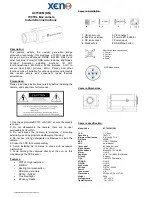
427-0100-00-12 Version 100
December 2018
5
The information contained herein does not contain technology as defined by EAR,15 CFR772, is publicly available, and therefore not subject to EAR.
Installation
1.2.3
Additional Supplies
The installer might need to supply the following items as required (specific to the installation).
•
PoE power supply or PoE switch for camera power.
•
Cat5e or Cat6 Ethernet cable for digital video and PoE for system power.
•
Ten-conductor accessory cable for auxiliary power and alarm in/out.
•
Camera grounding strap, camera mount, electrical hardware, connectors, and tools.
1.2.4
Site Preparation
The following recommendations provide for proper installation and operation of the unit
.
Adhere to all
local and industry standards, codes, and best practices.
•
Ambient Environment Conditions
: Avoid positioning the unit near heaters or heating system
outputs. Avoid exposure to direct sunlight.
•
Safety
: Cables and electrical cords should be routed in a manner that prevents safety hazards.
Ensure that nothing rests on the unit’s cables or power cords.
•
Ample Air Circulation
: Leave enough space around the unit to allow free air circulation.
•
Cabling Considerations
: Using a cable longer than the manufacturer’s specifications for
optimal video signal may result in degradation of color and video parameters.
•
Physical Security
: The unit provides threat detection for physical security systems. In order to
ensure that the unit cannot be disabled or tampered with, the system should be installed with
security measures regarding physical access by trusted and untrusted parties.
•
Network Security
: The unit transmits over IP to security personnel for video surveillance.
Proper network security measures should be in place to assure networks remain operating and
free from malicious interference. Install the unit on the backbone of a trusted network.
•
Electrostatic Discharge Safeguards
: The unit and other equipment connected to it (relay
outputs, alarm inputs, racks, carpeting, etc.) shall be properly grounded to prevent electrostatic
discharge.
1.2.5
Configure for Networking
Ethernet
Camera
connector
Guide
pins
The Saros Dome camera ball and back box are shipped in
separate boxes. The camera ball can be configured for
networking while still in its shipping box using PoE, or after
installation. If you are configuring the camera for networking
before installation, power the camera using a PoE switch or
PoE injector.
By default, a Dynamic Host Configuration Protocol (DHCP)
server on your network dynamically sets the camera’s IP
address. If there is no DHCP server on the network,
192.168.0.250 is the camera’s default IP address.
You can specify another IP address for the camera and
configure it for networking with the FLIR Discovery Network
Assistant (DNA) software tool or the camera’s web page.







































